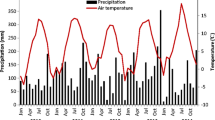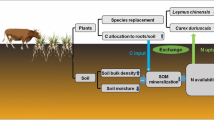Abstract
Aims
The objectives of this study were to compare techniques for measuring biological nitrogen fixation (BNF) and to assess how fertiliser N input affects the balance between BNF and sustainable herbage production on perennial ryegrass (Lolium perenne L.)/white clover (Trifolium repens L.) grassland.
Methods
Biological N fixation and herbage production by white clover based grassland was measured in 2011 and 2012 under four nominal annual fertiliser N inputs: 0 (0N), 86 (86N), 140 (140N) and 280 kg ha−1 (280N). Biological N fixation was measured using the 15N isotope dilution and 15N natural abundance techniques under all fertiliser N inputs and also using the nitrogen difference technique under 0N.
Results
The two 15N techniques produced similar annual estimates of above-ground BNF across the range of fertiliser N inputs. Fertiliser N input resulted in higher herbage dry matter yield, but reduced annual BNF which averaged 80, 64, 66 and 47 kg ha−1 on 0N, 86N, 140N and 280N, respectively, across both techniques and years.
Conclusions
The two 15N techniques were comparable in estimating BNF. Intermediate fertiliser N inputs achieved a balance between minimising detrimental impact on BNF and potential N loss while producing more herbage DM yield than clover swards receiving no fertiliser N.






Similar content being viewed by others

References
Boddey RM, Peoples MB, Palmer B, Dart PJ (2000) Use of the 15N natural abundance technique to quantify biological nitrogen fixation by woody perennials. Nutr Cycl Agroecosyst 57:235–270. doi:10.1023/a:1009890514844
Bontemps C, Elliott GN, Simon MF, dos Reis Junior FB, Gross E, Lawton RC, Neto NE, Loureiro MF, de Faria SM, Sprent JI, James EK, Young JPW (2010) Burkholderia species are ancient symbionts of legumes. Mol Ecol 19:44–52
Bouman OT, Mazzocca MA, Conrad C (2010) Soil NO3 −leaching during growth of three grass-white-clover mixtures with mineral N applications. Agric Ecosyst Environ 136:111–115
Burchill W, Li D, Lanigan GJ, Williams M, Humphreys J (2014) Inter-annual variation in nitrous oxide emissions from perennial ryegrass/white clover grassland used for dairy production. Glob Chang Biol. doi:10.1111/gcb.12595
Cadisch G, Sylvester-Bradley R, Nösberger J (1989) 15N-Based estimation of nitrogen fixation by eight tropical forage-legumes at two levels of P:K supply. Field Crop Res 22:181–194. doi:10.1016/0378-4290(89)90091-9
Carlsson G, Huss-Danell K (2003) Nitrogen fixation in perennial forage legumes in the field. Plant Soil 253:353–372
Carlsson G, Huss-Danell K (2014) Does nitrogen transfer between plants confound 15N-based quantifications of N2 fixation? Plant Soil 374:345–358. doi:10.1007/s11104-013-1802-1
Carranca C, de Varennes A, Rolston D (1999) Biological nitrogen fixation by fababean, pea and chickpea, under field conditions, estimated by the 15N isotope dilution technique. Eur J Agron 10:49–56
Chalk PM, Ladha JK (1999) Estimation of legume symbiotic dependence: an evaluation of techniques based on 15N dilution. Soil Biol Biochem 31:1901–1917. doi:10.1016/S0038-0717(99)00095-4
Choi WJ, Lee SM, Ro HM, Kim KC, Yoo SH (2002) Natural 15N abundances of maize and soil amended with urea and composted pig manure. Plant Soil 245:223–232. doi:10.1023/A:1020475017254
CSO (2014) Agricultural input and output absolute prices. Central Statistics Office, Cork, Ireland. Available online at: http://www.cso.ie
Davies A (2001) Competition between grasses and legumes in estiblished pastures. In: Tow PG, Lazenby (eds) Competition and succession in pastures. CABI, Oxon
Doughton JA, Saffigna PG, Vallis I, Mayer RJ (1995) Nitrogen-fixation in chickpea. 2. Comparison of 15N enrichment and 15N natural abundance methods for estimating nitrogen fixation. Aust J Agric Res 46:225–236. doi:10.1071/ar9950225
Draaijers GPJ, Ivens WPMF, Bos MM, Bleuten W (1989) The contribution of ammonia emissions from agriculture to the deposition of acidifying and eutrophying compounds onto forests. Environ Pollut 60:55–66
Evans J, O’Connor GE, Turner GL, Bergersen FJ (1987) Influence of mineral nitrogen on nitrogen fixation by lupin (Lupinus angustifolius) as assessed by 15N isotope dilution methods. Field Crop Res 17:109–120. doi:10.1016/0378-4290(87)90086-4
Fitzgerald D, Fitzgerald D (2004) Meteorological measurements. In: T Keane, JF Collins (eds) Climate, weather and Irish agriculture
Hogh-Jensen H, Schjoerring JK (1994) Measurement of biological dinitrogen fixation in grassland-comparison of the enriched 15N isotope dilution and the natural 15N abundance methods at different nitrogen application rates and defoliation frequencies. Plant Soil 166:153–163
Hogh-Jensen H, Schjoerring JK (2010) Interactions between nitrogen, phosphorus and potassium determine growth and N2 fixation in white clover and ryegrass leys. Nutr Cycl Agroecosyst 87:327–338. doi:10.1007/s10705-009-9341-0
Holdensen L, Hauggaard-Nielsen H, Jensen ES (2007) Short-range spatial variability of soil δ15N natural abundance – effects on symbiotic N2 fixation estimates in pea. Plant Soil 298:265–272. doi:10.1007/s11104-007-9367-5
Huber H, Jacobs E, Visser EJW (2009) Variation in flooding-induced morphological traits in natural populations of white clover (Trifolium repens) and their effects on plant performance during soil flooding. Ann Bot 103:377–386. doi:10.1093/aob/mcn149
Humphreys J, Mihailescu E, Casey IA (2012) An economic comparison of systems of dairy production based on N-fertilized grass and grass-white clover grassland in a moist maritime environment. Grass Forage Sci 67:519–525. doi:10.1111/j.1365-2494.2012.00871.x
Huss-Danell K, Chaia E (2005) Use of different plant parts to study N2 fixation with 15N techniques in field-grown red clover (Trifolium pratense). Physiol Plant 125:21–30. doi:10.1111/j.1399-3054.2005.00530.x
James EK, Sprent JI, Minchin FR, Brewin NJ (1991) Intercellular location of glycoprotein in soybean nodules: effect of altered rhizosphere oxygen concentration. Plant Cell Environ 14:467–476. doi:10.1111/j.1365-3040.1991.tb01516.x
Ledgard SF (1991) Transfer of fixed nitrogen from white clover to associated grasses in swards grazed by dairy cows, estimated using 15N methods. Plant Soil 131:215–223. doi:10.1007/bf00009451
Ledgard S (2001) Nitrogen cycling in low input legume-based agriculture, with emphsis on legume/grass pastures. Plant Soil 228:43–59
Ledgard S, Simpson J, Freney J, Bergersen F (1985) Field evaluation of 15N techniques for estimating nitrogen fixation in legume-grass associations. Aust J Agric Res 36:247–258. doi:10.1071/AR9850247
Ledgard SF, Sprosen MS, Penno JW, Rajendram GS (2001) Nitrogen fixation by white clover in pastures grazed by dairy cows: temporal variation and effects of nitrogen fertilization. Plant Soil 229:177–187
Ledgard SF, Schils R, Eriksen J, Luo J (2009) Environmental impacts of grazed clover/grass pastures. Ir J Agric Food Res 48:209–226
Lesuffleur F, Salon C, Jeudy C, Cliquet JB (2013) Use of a 15N2 labelling technique to estimate exudation by white clover and transfer to companion ryegrass of symbiotically fixed N. Plant Soil 369:187–197. doi:10.1007/s11104-012-1562-3
Li D, Humphreys J, Lanigan G (2011) Measured and simulated nitrous oxide emissions from ryegrass- and ryegrass/white clover-based grasslands in a moist temperate climate. PLoS ONE 6(10):e26176. doi:10.1371/journalpone0026176
Mathieu O, Lévêque J, Hénault C, Ambus P, Milloux M-J, Andreux F (2007) Influence of 15N enrichment on the net isotopic fractionation factor during the reduction of nitrate to nitrous oxide in soil. Rapid Commun Mass Spectrom 21:1447–1451. doi:10.1002/rcm.2979
Menneer JC, Ledgard S, McLay C, Silvester W (2003) The effect of a single application of cow urine on annual N2 fixation under varying simulated grazing intensity, as measured by four 15N isotope techniques. Plant Soil 254:469–480
Oberson A, Frossard E, Bühlmann C, Mayer J, Mäder P, Lüscher A (2013) Nitrogen fixation and transfer in grass-clover leys under organic and conventional cropping systems. Plant Soil 371:237–255. doi:10.1007/s11104-013-1666-4
O’Donovan M, Lewis E, O’Kiely P (2011) Requirements of future grass-based ruminant production systems in Ireland. Ir J Agric Food Res 50:1–21
Phelan P, Casey IA, Humphreys J (2014) The effects of simulated summer-to-winter grazing management on herbage production in a grass–clover sward. Grass Forage Sci 69:251–265. doi:10.1111/gfs.12041
Pirhofer-Walzl K, Rasmussen J, Høgh-Jensen H, Eriksen J, Søegaard K, Rasmussen J (2012) Nitrogen transfer from forage legumes to nine neighbouring plants in a multi-species grassland. Plant Soil 350:71–84. doi:10.1007/s11104-011-0882-z
Rasmussen J, Søegaard K, Pirhofer-Walzl K, Eriksen J (2012) N2 fixation and residual N effect of four legume species and four companion grass species. Eur J Agron 36:66–74. doi:10.1016/j.eja.2011.09.003
Ravishankara AR, Daniel JS, Portmann RW (2009) Nitrous Oxide (N2O): the dominant ozone-depleting substance emitted in the 21st century. Science 326:123–125. doi:10.1126/science.1176985
Robinson D (2001) δ15N as an integrator of the nitrogen cycle. Trends Ecol Evol 16:153–162. doi:10.1016/S0169-5347(00)02098-X
Trott H, Wachendorf M, Ingwersen B, Taube F (2004) Performance and environmental effects of forage production on sandy soils. I. Impact of defoliation system and nitrogen input on performance and N balance of grassland. Grass Forage Sci 59:41–55. doi:10.1111/j.1365-2494.2004.00405.x
Unkovich M (2013) Isotope discrimination provides new insight into biological nitrogen fixation. New Phytol 198:643–646. doi:10.1111/nph.12227
Unkovich M, Pate S (2000) An appraisal of recent field measurements of symbiotic N2 fixation by annual legumes. Field Crop Res 65:211–228
Unkovich M, Herridge D, Peoples M, Cadisch G, Boddey B, Giller K, Alves B, Chalk P (2008) Measuring plant-associated nitrogen fixation in agricultural systems. Australian Center for International Agricutural Research, Canbera
Yan M-J, Humphreys J, Holden NM (2013) The carbon footprint of pasture based milk production: can white clover make a difference? J Dairy Sci 96:857–865
Acknowledgments
This work was funded by the EU Framework Programme 7 project Legume Futures. The author thanks Laura Lopez del Egido and the Stable Isotope Facility at the James Hutton Institute for assistance with the B s -value analyses and Kevin McNamara, internship students and the staff of Solohead Research Farm for assistance with field sampling.
Author information
Authors and Affiliations
Corresponding author
Additional information
Responsible Editor: Katharina Pawlowski.
Electronic supplementary material
Below is the link to the electronic supplementary material.
Table S.1
Shoot δ15N values of perennial ryegrass and a combination of weed species in the June 2012 harvest and their effect on the proportion of N derived from the atmosphere (%Ndfa) in clover when used as reference plants using the 15N natural abundance technique on treatments receiving annual fertiliser N inputs of 0 (0N), 86 (86N), 140 (140N) and 280 (280N) kg ha−1. (DOC 57 kb)
Fig S.1
Proportion of nitrogen derived from the atmosphere (%Ndfa) in white clover estimated by 15N isotope dilution (ID) data (white circle), 15N natural abundance data (black box) and 15N ID data using a B s -value (grey triangle) on the final three harvest dates and a supplementary harvest in March 2013 (mm–yy) on treatments receiving annual fertiliser N input of (a) 0, (B) 86, (c) 140 and (d) 280 kg ha−1. Error bars represents the interaction S.E.M of harvest date × technique. (GIF 3 kb)
Rights and permissions
About this article
Cite this article
Burchill, W., James, E.K., Li, D. et al. Comparisons of biological nitrogen fixation in association with white clover (Trifolium repens L.) under four fertiliser nitrogen inputs as measured using two 15N techniques. Plant Soil 385, 287–302 (2014). https://doi.org/10.1007/s11104-014-2199-1
Received:
Accepted:
Published:
Issue Date:
DOI: https://doi.org/10.1007/s11104-014-2199-1



